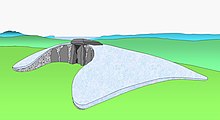Tinkinswood
Coordinates: 51 ° 27'5.1 " N , 3 ° 18'28.5" W.
The megalithic complex of Tinkinswood (also called Castell Carreg, Llech-y-Filiast, Maes-y-Filiast or Gwal-y-Filiast - names associated with the saga of King Arthur ) is a Cotswold Severn type complex . In the Neolithic , around 4000 BC. Built about a kilometer northwest of the dolmen of St. Lythans, in the small valley of Glamorgan in Wales .
description
The almost rectangular stone mound of 40 m × 18 m has a rectangular chamber in the front, which is drawn in in the middle. The front, known as the “horned forecourt”, lies in the northeast and consists of dry stone masonry , which was partly built in a herringbone pattern and which was partially restored after the excavation in 1914. The sloping masonry is completely different from the vertical one in the nearby Parc Cwm . The enormous, lightweight, sloping capstone of the chamber, measuring 7.4 mx 4.5 m and weighing around 40 tons, is the largest in Great Britain . It lies on preserved and replaced bearing stones. The south side of the chamber was destroyed and the contents of the grave were disturbed .
920 pieces of mostly broken human bones were found in the chamber. They come from around 50 people of both sexes and ages. There is a stone-lined pit in the hill. It is possible that corpses were allowed to rot in it before the remains were deposited in the chamber. A number of parallel rows of upright stones have been found within stone mound, as has a walled pit containing animal bones. Flint chips , bone needles and the shards of red, undecorated Neolithic ceramics and pottery from the bell-cup culture indicate that the facility was used until the Bronze Age .
Say
Tinkinswood has several legends over the years. The best known is that someone who spends a night here on May 1st, St. John's Day (June 23rd), or the day before the winter solstice, either dies, goes mad, or becomes a poet. A group of boulders in the south of the monument are said to be frozen women who met here to dance on the Sabbath.
See also
literature
- Vicki Cummings, Alasdair Whittle: Places of special virtue. Megaliths in the Neolithic landscapes of Wales. Oxbow, Oxford 2004, ISBN 1-84217-108-9 , p. 180.
- Homer Sykes: Mysterious Britain - Fact and Folklore George Weidenfeld & Nicolson Ltd. 1993 ISBN 0-297-83196-8 p. 113



